
We Made These 10 Social Media Mistakes so You Don’t Have To

Product Marketing @ Buffer
This might sound contradicting — and it’s scary for us to admit.
But, despite building a product that helps people succeed on social media, we have committed a good number of social media mistakes ourselves.
Mistakes that have cost us reach and engagement, maybe even fans and customers.
Now that we have learned from many of those mistakes, I would love to share our top 10 and how you can avoid committing them yourself.
Let’s get started…

Learn from These 10 Social Media Mistakes We’ve Made
Here’s a quick overview of the social media mistakes we’ve been making until recently:
- Focusing on quantity over quality
- Being on all social media platforms
- Posting the same content across platforms
- Using only landscape images and videos
- Sharing only our own content
- Not curating user-generated content
- Not uploading videos to social media platforms
- Not targeting specific audience for our content
- Not boosting the right posts
- Not replying to questions on social (fast enough)
Interested in listening to this post in the podcast format? We invite you to check out an episode on this topic in Buffer’s very own podcast – The Science of Social Media!

Mistake 1: Focusing on quantity over quality
Posting less 3X our reach and engagement
We were posting way too much.
Just last year, we were posting four to five times to our Facebook Page and tweeting up to 14 times per day.
As we have been producing a lot of content on our blogs and podcast, we had many things to share. So we shared — a lot. Also, to fill our Buffer queue, we might have included content which was good, but perhaps not the best.
When we posted less (once or twice per day) to our Facebook Page, our reach and engagement increased by three-fold.
Limiting our Facebook posts to just one or two per day forced us to share only the best content. These quality posts resonated with our Facebook fans, and the Facebook algorithm surfaced them to more people.

Small business owners and solo social media managers usually don’t have the time to create or find enough high-quality content to post five times a day on Facebook or tweet 10 times a day on Twitter. By reducing the number of times you post each day, you can focus on the quality of the posts rather than the quantity of posts.
Mistake 2: Being on all social media platforms
Fewer channels, more focus, better content
As a social media management company, we feel a duty to test out all social media platforms so that we can understand how each platform works and can share what we’ve learned about succeeding on each platform…
…what we’ve not been so great at is deciding when to stop using a certain platform.
Only after we took a break from Snapchat and after Instagram introduced similar Stories features, we gradually stopped posting to Snapchat and focused on Instagram.
We weren’t getting the results we want for the time and effort we put into Snapchat and most of the users on Snapchat aren’t our target audience. Whereas Instagram provides several advantages such as better discoverability, analytics (including audience insights), and audience targeting through ads.

Every additional platform your business is active on means additional time and effort required to create great tailored content for that platform and engage with your fans on that platform.
Take stock of your social media profiles and consider which channels are performing for your business and which are not. By moving away from social media platforms that might not suit your business or not be performing well, you can double down on those that are.
Mistake 3: Posting the same content across platforms
Tailored content for each platform increases reach and engagement
We often recommend people to share unique content for each of the social media platforms because the platforms are set up differently and people have different expectations for the content they want to see on each platform.
For instance, on Instagram, hashtags can help to increase your reach, but they don’t quite have the same effect on Facebook.
To help solve this problem, we recently improved our product so that you can customize your posts for each social media platform and share them to your profiles all at once.
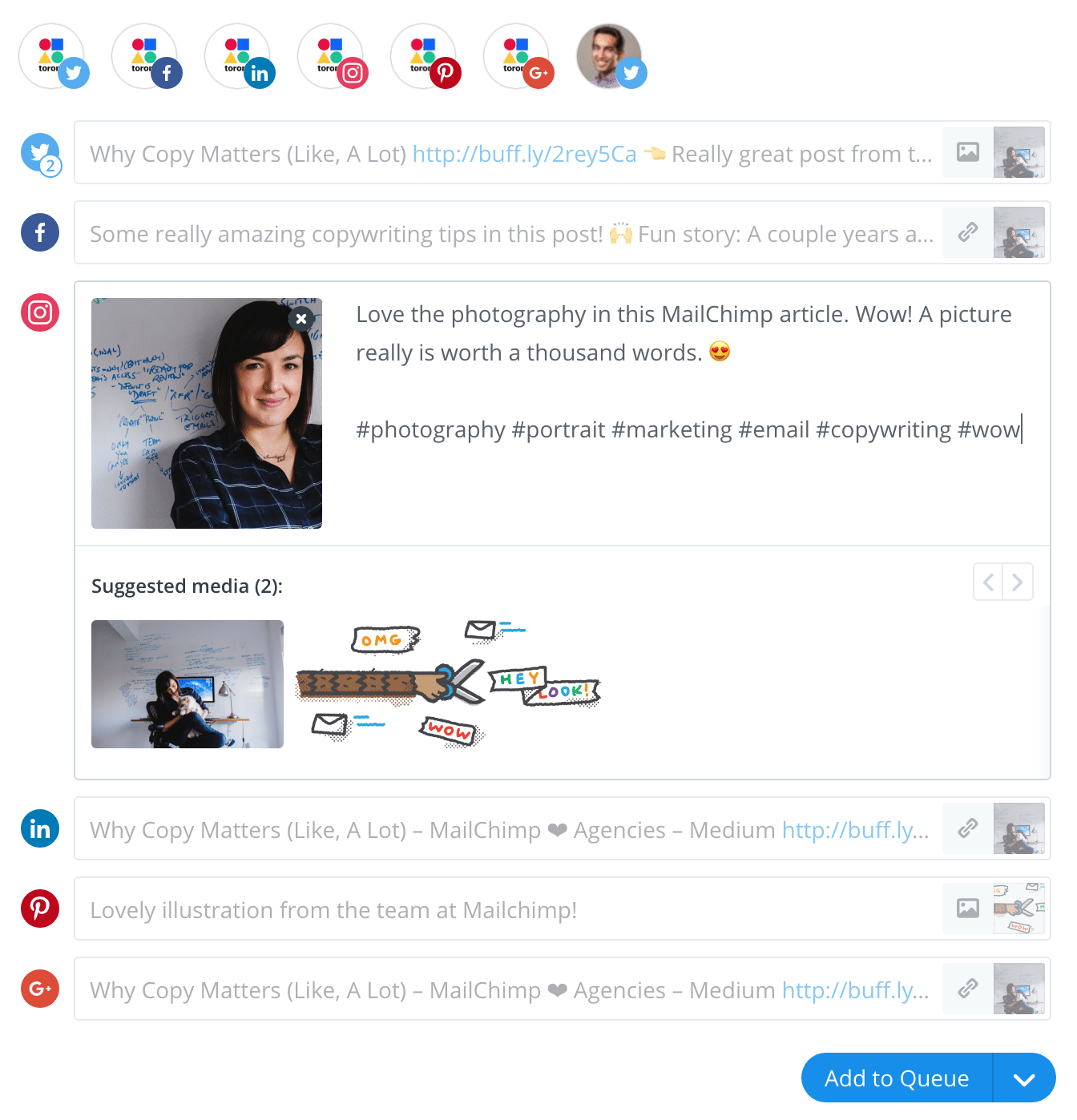
We would love for you to give it a try if you haven’t had a chance to! Just compose a post on your Buffer dashboard or through the Buffer extension to try this new feature.
Mistake 4: Using only landscape videos and images
Square videos have higher average views and engagement
We were used to posting landscape videos and images because that was the ideal image size for most social media platforms such as Facebook and Twitter.
1,024 pixels by 512 pixels.
But that might not be true anymore. As square videos and images are no longer cropped on Facebook and Twitter, they take up more real estate on someone’s feed — 78% more, in fact.
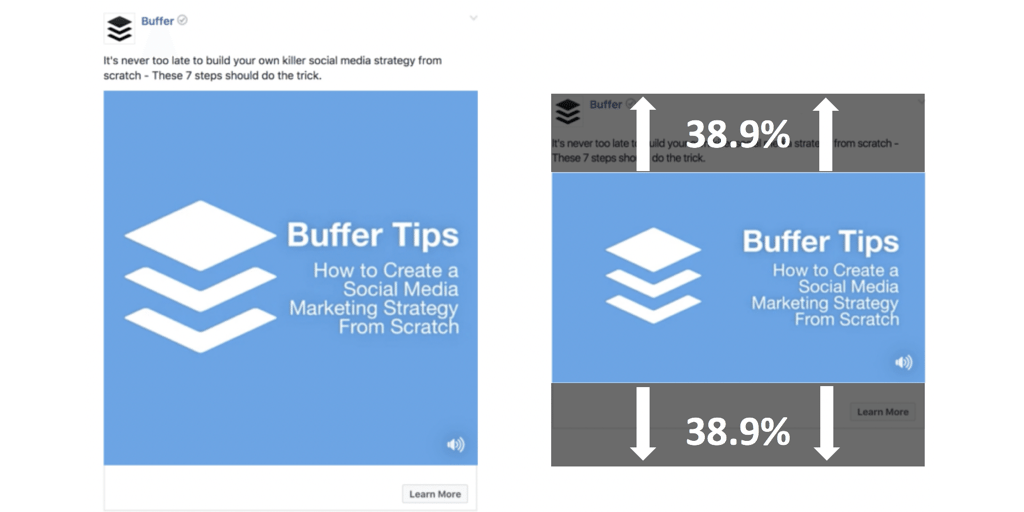
After spending $1,500 on experiments, we found that square videos actually generate higher average views and engagement, especially on mobile phones, than landscape videos.
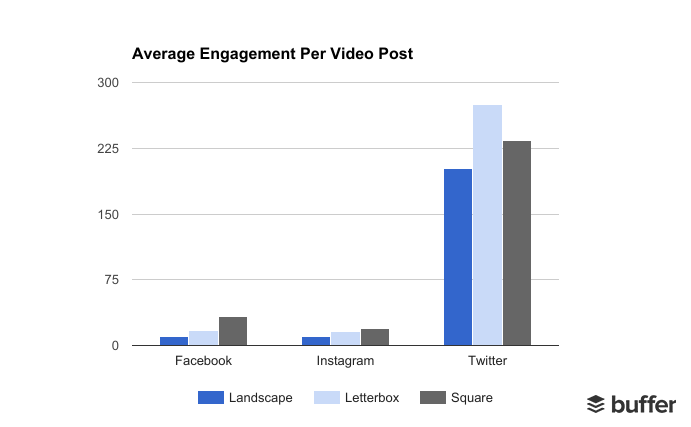
Once we discovered these findings, we started posting more square videos and images on our Facebook Page and Twitter profile. It could be worth experimenting with square videos and images to see if they perform better for you, too.
Another fun experiment to explore might be posting vertical videos and images, especially since Facebook is showing a larger preview of vertical videos on its mobile feed.
Do you have any experience with vertical multimedia? How do they perform compared with landscape or square multimedia?
Mistake 5: Sharing only our own content
Curated content helped grow our Facebook fan base
We used to shy away from curated content because we thought it wouldn’t contribute to our bottom-line: traffic, signups, and revenue. It even felt counter-intuitive. Do we really want to send traffic to someone else’s website than our own?
Then, we realized that might have been a short-sighted thinking. While we were marketing to our fans, we weren’t growing our fan base much. So we were marketing to mostly the same people who could potentially be annoyed by too much Buffer content.
When we experimented with posting also content from other sources such as TechCrunch and Wired, our Page’s reach, engagement, and fans grew significantly.
Five out of our recent top 10 Facebook posts are curated from others. In total, they reached over 1.7 million people, most of whom are (or were) not our Facebook Page fans. (For context, we have about 93,000 Facebook Page fans.)
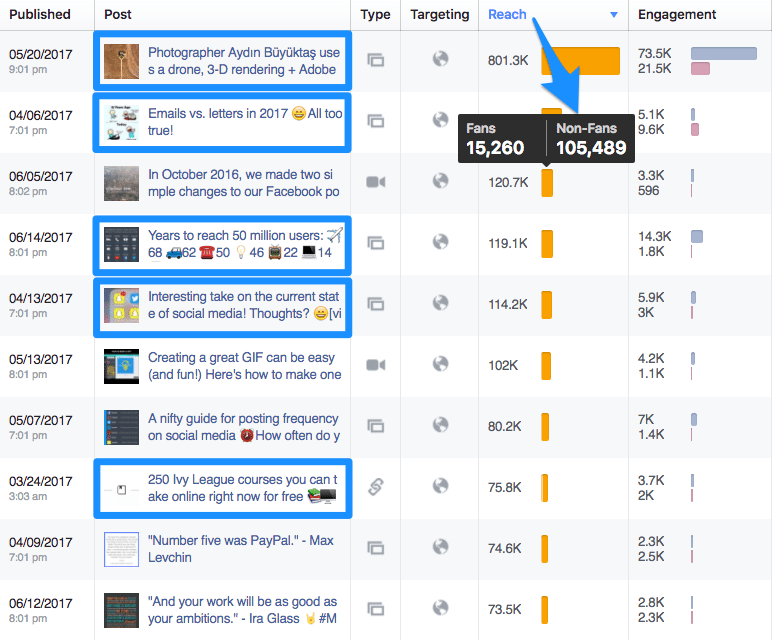
Posting quality content from others increased our brand awareness and following on Facebook. These pieces of content reached people who may not have heard of Buffer before and converted some of them into our Facebook Page fans. Now, we can share Buffer content to a bigger engaged audience.
To quickly find great relevant content on Facebook, use the Pages to Watch feature in your Facebook Page Insights. Here’s a quick video on how it works:
Mistake 6: Not curating user-generated content (UGC)
UGC grew our Instagram account by 500% within six months
We were trying many different strategies with our Instagram account when we first started it in 2013. We posted photos of our retreats and our meetups, took turns to share about our daily lives, and promoted our weekly Twitter chat, #bufferchat.
It was fun trying all those Instagram strategies, but few people were interested in the content we posted. Our Instagram account wasn’t growing much, and there were few interactions on our posts. Then, we found a strategy that grew our Instagram following by about 500 percent (4,250 to 21,000 and counting) within six months.
The strategy? Curating user-generated content.
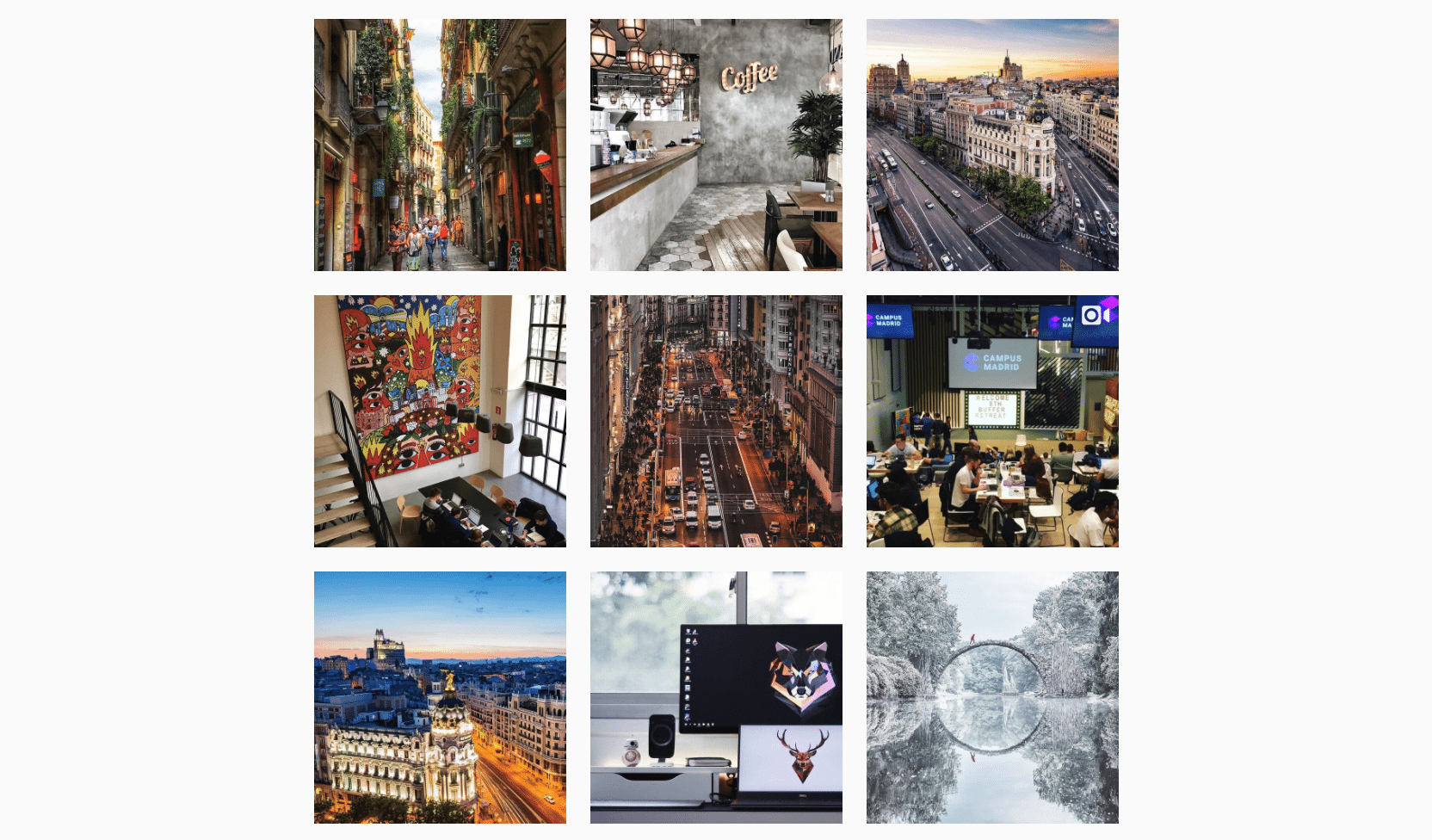
By curating photos that our target audience is interested in (and posting a few Buffer news), we have been able to grow a large engaged following on Instagram—with whom we share social media and marketing tips through Instagram Stories and live videos.
This is the technique we use to quickly find and share UGC on our Instagram profile:
Mistake 7: Not uploading videos onto social media platforms
Native videos are shared five times more than YouTube videos on social
Quintly analyzed over six million Facebook posts and found that videos uploaded onto Facebook receive more engagement and shares than YouTube videos on Facebook.
The interaction rate for Facebook native videos were on average 109.67% higher than for YouTube videos.
…
Facebook native videos had on average a 477.76% higher share rate compared to Youtube videos.
But just a year ago, we were still sharing YouTube links to our videos rather than uploading our videos onto the social media platforms (even when we could upload videos onto Facebook, Twitter, Pinterest, Google+, and LinkedIn through Buffer ?).
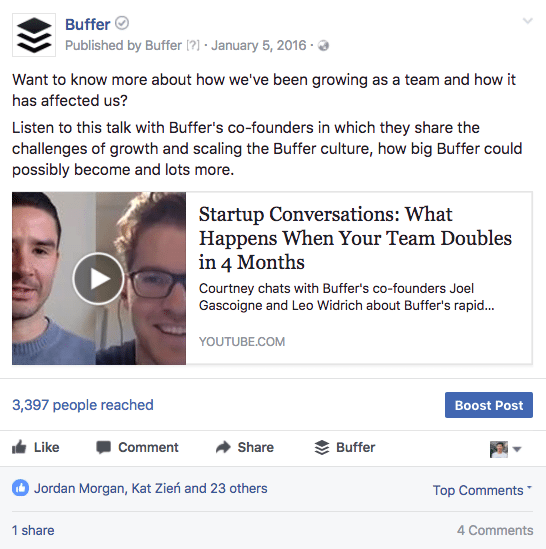
When we were posting YouTube links, our best video post (the one above) only reached 3,397 people. Now, videos we upload onto Facebook receive an average reach of 53,254.
Mistake 8: Not targeting specific audience for our content
Setting preferred audience made our content more relevant
Whenever we have a meetup or workshop, we used to share about the event on our Facebook Page with all our fans.
The issue was that the events are usually in a particular location while our fans are from all around the world. If you are based in London, you most likely won’t find our New York meetup relevant.
So we started using Facebook’s preferred audience feature for such localized posts. For example, when we held a workshop in Philadelphia this year, we restricted the post so that only people in Philadelphia would see it.
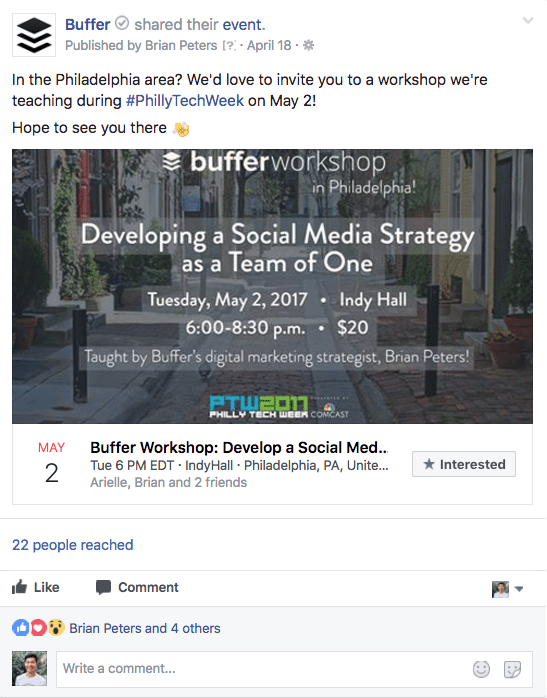
While it reached fewer people than most of our Facebook posts, it was highly relevant to them as they Liked our Facebook Page (indicating an interest in our content and events) and live in Philadelphia. At the same time, our fans outside of Philadelphia wouldn’t have seen this post, which was likely to be less relevant to them.
Facebook’s algorithm assigns a personalized relevancy score to every post you can see and shows you the post that is most relevant to you first. By limiting your posts only to the relevant audience, Facebook might more likely show your posts than less relevant posts from other brands, to the audience. This is especially useful for local businesses that have a local target audience.
Mistake 9: Not boosting the right posts
Top-performing posts do even better when boosted
When I first started with Facebook ads, I wasn’t sure what do to. In particular, I was boosting posts which I think might do well purely based on gut feeling. That didn’t go well.
Fortunately, I learned a great tip from Brian Peters, our Digital Marketing Strategist. The engagement rate on your existing Facebook posts gives you a good indication of how successful the post is likely to be when boosted.
Here’s how you can find the best Facebook posts to boost:
- Go to your Facebook Page Insights’ Posts tab
- Click on the drop-down menu in the upper left corner of the “All Posts Published” and select “Engagement Rate”
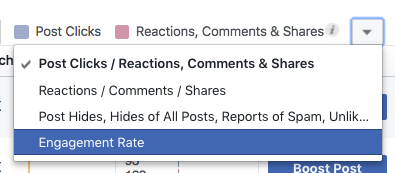
The posts you want to boost are those with above average engagement rate. For us, that’s posts with 6 percent or higher engagement rate.
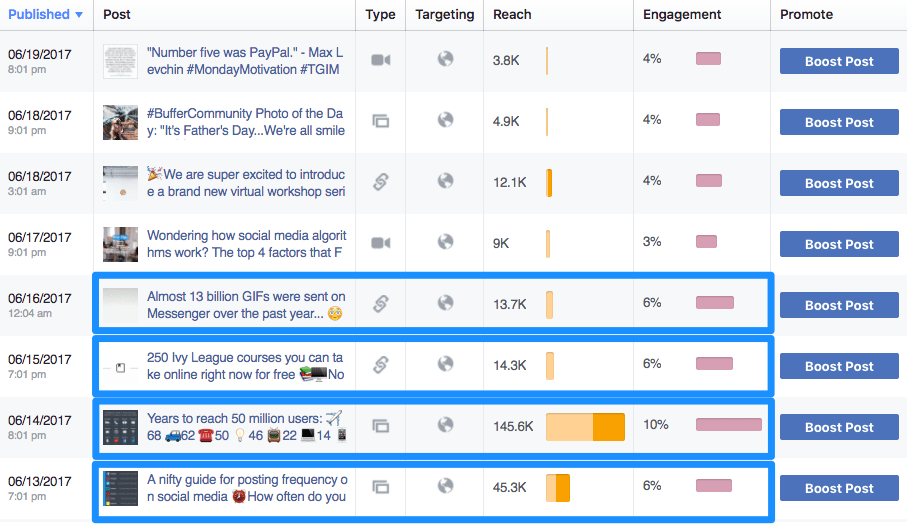
You can also use this approach with Twitter, Instagram, and Pinterest. Twitter Analytics also provides you with the engagement rate of individual tweets. For Instagram and Pinterest, you’ll need to manually calculate the engagement rates for each post (you can do this by dividing the total engagement with the reach for Instagram or the impressions for Pinterest).
This approach is great because it encourages you to create quality content that generates great reach and engagement first before spending advertising money to boost your reach. It also prevents you from becoming over-reliance on ads to get reach on social media. As Gary Vaynerchuk said, “no amount of paid media is going to turn bad creative into good content”.
Mistake 10: Not replying to questions on social
70% are more likely to use a brand’s product when the brand responds on social
Surprisingly, brands ignore 89 percent of people who want a response, according to Sprout Social’s research.
In the same research, Sprout Social found these great benefits if a brand were to respond to customers’ questions on social media:
- 70% of people are more likely to use the brand’s product or service.
- 65% of people have more brand loyalty.
- 75% of people are likely to share a good experience on their own profile.
While we reply to most questions on our social media profiles, an area we’re working on is to reply (even) faster. Jay Baer found that 42 percent of people who have reached out to a brand on social media for customer support expect a response within 60 minutes.
Using Reply (or your preferred social monitoring and engagement tools), you can quickly respond to all mentions and messages on your Twitter profile, Facebook Page, and Instagram profile from one place.


What other social media mistakes are we committing?
Those are the top 10 social media mistakes we’ve committed and the lessons we’ve learned. I hope you find them useful while planning your social media strategy.
Do you notice anything we could do better on social media? We’ll be so grateful if you could let us know!
—
Image credit: Unsplash
Try Buffer for free
180,000+ creators, small businesses, and marketers use Buffer to grow their audiences every month.
Related Articles

TikTok just introduced Bulletin Boards, similar to Instagram's Broadcast Channels. Here's what you need to know.

Video, photos, carousels, or text? We dug into Buffer’s data, analyzing millions of social posts from Instagram, TikTok, LinkedIn, Facebook, Threads, and X to find out which content format performs best.

In this article, you'll find 20+ essential LinkedIn statistics that reveal the platform's reach, effectiveness, and continued growth.